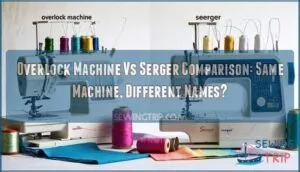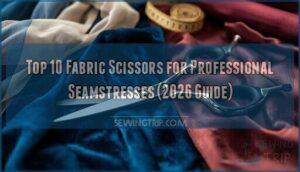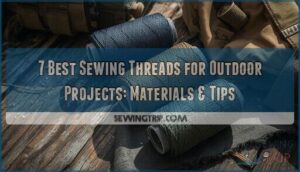This site is supported by our readers. We may earn a commission, at no cost to you, if you purchase through links.

You’re not comparing apples to oranges here; you’re looking at the same apple with two different labels. "Serger" is the American term, while "overlock" is used internationally.
Both machines create the same professional-looking overlock stitches that prevent fabric edges from fraying. They cut, stitch, and finish seams simultaneously at lightning speed.
Whether you call it a serger or overlock, you’ll get identical functions: multiple thread cones, built-in cutting blades, and differential feed systems. The real differences lie in specific models and brands, not the terminology itself.
Table Of Contents
Key Takeaways
- You’re comparing identical machines – Sergers and overlock machines are the exact same equipment with different regional names (Americans say "serger," others say "overlock")
- Both create professional stitches at identical speeds – Whether you call it a serger or overlock, you’ll get 1,300-1,500 stitches per minute and the same edge-finishing capabilities
- Focus on model features, not terminology – Your decision should be based on specific machine capabilities like thread options, differential feed, and stitch quality rather than the name
- Regional preferences don’t affect functionality – North American "serger" marketing vs. international "overlock" terminology creates confusion, but the machines perform identical cutting, stitching, and finishing operations
Serger Machine Basics
You’ll find that a serger machine is a specialized sewing tool designed to trim fabric edges while simultaneously wrapping them in thread to prevent fraying.
This powerful machine creates professional-looking seams at lightning speed, making it perfect for finishing garment edges and working with stretchy knit fabrics.
Serger Machine Definition
Looking at the needle and thread, a serger machine is a specialized sewing tool designed for one machine purpose: creating professional overlock stitches.
Your serger uses multiple thread pathways—typically three or four—to simultaneously trim fabric edges and encase them in interlocking loops.
Multiple threads work together to trim, wrap, and secure fabric edges in one swift motion.
This stitch formation prevents fraying while joining seam allowances in a single operation, making it essential for finishing raw edges on garments, using interlocking loops.
Serger Machine Functions
Your serger machine functions like a multitasking workhorse, trimming fabric edges while simultaneously creating secure overlock stitches.
Edge trimming happens automatically as sharp blades cut excess material, while loopers form interlocking threads around raw edges.
Seam finishing becomes effortless with differential feed controlling fabric flow, preventing stretching in knit fabrics, delivering professional results in one smooth operation.
These machines create a durable overlock stitch commonly used on commercial clothing, utilizing a secure overlock stitch formation process.
Serger Machine Benefits
When you work with knit fabrics, you’ll appreciate how a serger machine delivers seam durability that regular machines can’t match.
These serger features create professional results through faster sewing speeds and superior edge finishing.
Your projects benefit from the overlock vs serger comparison showing identical capabilities – both prevent fraying while maintaining stretch in activewear and casual garments.
Overlock Machine Basics
An overlock machine uses specialized stitching techniques to trim fabric edges while simultaneously encasing them in thread, preventing fraying and creating professional-looking seams.
You’ll find these machines excel at handling knit fabrics and creating stretchy, durable seams that won’t break when the fabric moves or stretches, making them ideal for professional-looking results.
Overlock Machine Definition
An overlock machine creates specialized stitches by simultaneously trimming fabric edges and encasing them with thread.
This machine purpose centers on edge finishing and seam construction through complex thread pathways involving loopers and needles.
The overlock machine’s stitch formation prevents fabric unraveling while creating professional-looking seams.
Many sewists discover that "overlock machine" and "serger machine" describe identical equipment with different regional names.
These machines often include a differential feed system to manage fabric stretch.
Overlock Machine Functions
Mastering your overlock machine means understanding what it can actually do for your sewing projects.
These powerful machines excel at specific tasks that’ll transform your finished garments.
Here’s what your overlock machine delivers:
- Seam Finishing – Trims and encases raw edges in one smooth motion, preventing fraying while you sew
- Edge Prevention – Creates durable thread casings around fabric edges that won’t unravel after washing
- Knit Fabrics – Produces stretchy seams that move with your fabric without breaking or puckering
- Speed Efficiency – Operates at 1,300-1,500 stitches per minute, completing projects faster than regular machines
Your overlock machine combines cutting, stitching, and finishing into one operation, making it perfect for professional-quality results.
Overlock Machine Benefits
You’ll discover that overlock machine benefits transform your sewing projects dramatically.
These machines deliver superior seam durability compared to regular sewing machines, making them perfect for knit fabrics that need stretch and strength.
Edge finishing becomes effortless as the overlock machine trims and encases raw edges simultaneously.
Faster sewing speeds up to 1,500 stitches per minute boost productivity substantially.
Professional results emerge naturally through precise fabric edge finishing that prevents fraying and unraveling completely, showcasing the professional results that can be achieved with these machines.
Key Differences Explained
You’ll discover that "serger" and "overlock machine" are simply different names for the exact same piece of equipment.
The terminology confusion comes from regional preferences, with North Americans saying "serger" while Europeans and Australians prefer "overlocker".
Terminology Differences
You’ll find that "serger" and "overlocker" represent the same machine with different regional terms.
This confusion often trips up sewers browsing tutorials or shopping guides. The overlock machine gets called a serger machine in North America, while other regions stick with "overlocker."
These cultural preferences create confusing tutorials when you’re following international patterns. Understanding that overlock vs serger debates miss the point—they’re identical machines—simplifies your shopping decisions substantially.
Regional Naming Variations
Regional naming differences stem from cultural influences and historical origins that shaped how each area adopted this technology.
In North America, manufacturers coined "serger" as their marketing name, while European and Australian companies preferred "overlocker".
You’ll encounter user confusion when shopping internationally or following tutorials from different regions.
Understanding these global terminology variations helps you navigate overlock machine and serger machine discussions regardless of your location or the sewing machine content you’re consuming.
Functional Similarities
Despite regional naming differences, you’ll find these machines perform identical functions.
Whether you call it a serger or overlock machine, you’re getting the exact same professional stitching power.
They offer the same speed efficiency and thread encasement capabilities, which is crucial for their operation.
Whether you choose a serger or overlocker, you’re getting identical serger benefits and overlock benefits—just different labels for the same technology, particularly with knit fabrics.
Serger Vs Overlock Comparison
You’ll notice that these machines share identical functions despite their different names.
While Americans call them sergers and others use overlocker, both create the same professional stitches at similar speeds of 1,300-1,500 stitches per minute.
Stitch Options Comparison
Both serger stitches and overlock stitches offer identical stitch patterns since these machines are functionally the same.
You’ll find 2-thread options for lightweight edge finishing, 3-thread configurations for general seaming, and 4-thread setups providing maximum stitch durability.
Advanced models include specialty threads capabilities for decorative stitches on knit fabrics, while industrial options offer expanded stitch varieties beyond basic sewing machine stitches.
A common choice is the 4-thread overlock stitch, which is frequently used in ready-to-wear garments.
Many sewers purchase a 4-thread overlock to create professional-looking seams.
| Stitch Type | Serger Application | Overlock Application |
|---|---|---|
| 2-Thread | Edge finishing, rolled hems | Lightweight seam finishing |
| 3-Thread | General construction seams | Medium-weight fabric seaming |
| 4-Thread | Heavy-duty knit construction | Maximum durability seaming |
Speed Comparison
When comparing sewing speed between these machines, you’ll find they’re virtually identical since they’re the same device.
Both domestic serger machines and overlock machines operate at 1,300-1,500 SPM, dramatically outpacing regular sewing machines at 650-1,000 SPM.
This speed advantage translates to faster project completion and improved efficiency factors for seam finishing.
Sergers, however, present a manageable learning curve, especially for those with prior sewing experience.
| Machine Type | Domestic Speed (SPM) | Industrial Speed (SPM) |
|---|---|---|
| Sewing Machine | 650-1,000 | 2,000-3,000 |
| Serger/Overlock | 1,300-1,500 | 5,000-7,000 |
| Production Rate | 2x faster | 3x faster |
| Seam Finishing | Simultaneous | Simultaneous |
| Learning Curve | Moderate | Steep |
The sewing machine vs serger speed differences become apparent during large projects where time matters most.
Fabric Handling Comparison
While speed matters, how your machine handles different materials makes the real difference in your sewing results.
Both overlock machine and serger machine excel at fabric handling through their differential feed system, but subtle variations exist in their approach to challenging materials.
| Fabric Type | Overlock Machine | Serger Machine |
|---|---|---|
| Knit Fabric | Standard differential feed | Enhanced stretch control |
| Delicate Fabrics | Gentle edge finishing | Precise blade adjustment |
| Heavy Fabrics | Multiple layers handling | Robust thread tension |
| Curved Seams | Consistent fabric edges | Smooth feed mechanism |
Your differential feed controls how fabric moves through the machine, preventing stretching on knits and puckering on delicate fabrics.
This technology keeps heavy fabrics feeding smoothly while maintaining clean fabric edges on curved seams.
Choosing The Right Machine
Now that you understand the similarities between sergers and overlockers, you’ll need to choose which machine fits your specific sewing needs.
Consider your skill level, the types of projects you plan to tackle, and how much you’re willing to spend on this specialized equipment.
Experience Level Considerations
Your sewing experience directly impacts which machine you’ll master fastest.
Beginners benefit from entry-level models with color-coded threading guides and simplified controls, making the initial learning curve less steep.
These beginner friendly options focus on core overlocking without overwhelming complexity.
Many sewers start with a beginner serger machine for ease of use.
Advanced sewers can handle professional machines with multiple thread options and differential feed systems, supporting advanced techniques and varied project complexity.
Your current sewing skills determine your ideal starting point, which is based on complete concepts of sewing.
Project Needs Assessment
Consider your Fabric Type and Project Complexity when choosing between a serger and overlock machine.
Heavy knits need durable Seam Durability, while delicate fabrics require gentle handling.
Your Stitch Requirements matter too—rolled hems versus basic edge finishing.
Sewing for beginners means simpler projects, but sewing machine comparison shows both machines excel at different tasks.
Match your Desired Finish to machine capabilities.
Evaluating your overlock project needs will help you select the right machine.
Budget Considerations
How much should you expect to shell out for these thread-cutting workhorses? Entry-level serger machines start around $200-300, while professional overlock models can hit $2,000.
Don’t forget maintenance expenses like replacement blades and regular tune-ups. Consider long-term value over initial sticker shock—a quality machine pays for itself through years of reliable service.
Many retailers offer financing options for budget-conscious sewers.
Advanced Features Overview
Now you’ll understand the technical features that make these machines work so efficiently.
These advanced systems—differential feed, knife mechanisms, and threading pathways—determine how well your machine handles different fabrics and creates professional-quality seams.
Differential Feed Technology
Your serger or overlock machine’s differential feed technology uses two feed dogs that can move at different speeds.
This fabric feed control prevents puckering on delicate materials and stops knit fabric sewing disasters.
You’ll adjust the feed ratio from 0.7 to 2.0—higher settings gather fabric while lower ones stretch it.
These differential benefits make tricky fabrics behave perfectly.
Knife Systems Explanation
Your overlock machine and serger feature dual-knife systems that work like precision scissors. The upper knife moves up and down while the lower knife stays put, creating clean cuts as you sew.
These blade types require regular maintenance tips and proper adjustment techniques for maximum cutting precision.
- Safety Mechanisms: Engage or disengage the upper knife using the control lever to prevent accidental cuts
- Cutting Precision: Adjust knife position to control stitch width and seam allowances for different projects
- Maintenance Tips: Replace dull blades regularly and check alignment to guarantee consistent fabric trimming
Threading Systems Overview
Threading your overlock machine doesn’t have to feel like solving a puzzle. Modern threading systems feature color-coded guides that match your thread spools to specific pathways, making the process straightforward.
You’ll thread loopers first, then needles, following the precise threading order your machine displays. Proper looper threading makes your overlock machine create balanced stitches.
| Threading Component | Function | Key Tip |
|---|---|---|
| Upper Looper | Creates top thread loop | Thread first for easier access |
| Lower Looper | Forms bottom thread loop | Check tension after threading |
| Needle Threads | Pierces fabric for seam | Thread last to prevent tangling |
When troubleshooting threading issues, check that each thread follows its designated path completely. Unlike sewing machine threading, serger threading requires precise tension balance between all threads to prevent skipped stitches or thread breaks; it’s important to test threading tension on fabric scraps, so you can confirm the threads are properly balanced.
Serger and Overlock Stitch Options
You’ll discover that sergers and overlock machines offer identical stitch options, since they’re the same machine with different names.
These versatile machines create three main stitch types that’ll transform your sewing projects from amateur to professional-looking.
They will make your projects look more polished and refined with the use of these versatile machines.
Overlock Stitch Explanation
Through the magic of stitch formation, your overlock machine creates incredibly strong seams by wrapping multiple threads around fabric edges.
The overlock stitch uses loopers instead of bobbins, allowing differential feed to prevent stretching while maintaining proper thread tension.
This technique simultaneously trims and finishes seam edges, delivering superior seam durability compared to regular sewing stitches.
Cover Stitch Explanation
Discover professional finishing with cover stitch capabilities that transform your garments from homemade to store-bought quality.
This specialized stitch creates parallel straight lines on top while forming zigzag patterns underneath.
Cover stitch types and uses include:
- Hemming knits – Creates stretchy, flat hems that won’t pop or pucker
- Topstitching seams – Adds decorative parallel lines with professional appeal
- Attaching elastic – Secures waistbands and cuffs without breaking threads
- Neckline finishing – Produces smooth, comfortable edges on T-shirts
- Chain stitch options – Single-needle mode for decorative accent work
Advanced combo models like the Janome 1000CPX CoverPro offer adjustable cover stitch needles, precise cover stitch tension controls, and specialized cover stitch feet for superior results.
Rolled Hem Stitch Explanation
Delicate fabrics need a gentle touch when creating rolled hems on your overlock machine or serger.
You’ll adjust tension settings lower than standard overlock stitch requirements, reducing stitch width to create that signature narrow finish.
Proper foot pressure prevents fabric distortion while troubleshooting hems becomes easier with practice on rolled hem fabrics, which helps in achieving a gentle touch.
Machine Selection Criteria
When you’re ready to buy your first serger or overlock machine, you’ll face dozens of models with features that range from basic to bewildering.
The key is matching the machine’s capabilities to your actual sewing needs rather than getting swept up in flashy extras you’ll never use.
This approach ensures that you purchase a machine that meets your needs, without overspending on features that are unnecessary for your sewing projects.
Entry-Level Machine Features
When choosing entry-level machines, you’ll find beginner friendly options that won’t break the bank.
These affordable price models offer basic stitches with simple threading systems, making them perfect for newcomers to serger and overlock machine territory.
- Thread configurations: Most entry-level machines handle 2, 3, or 4-thread setups for versatile edge finishing and seam construction
- Differential feed adjustment: Manual controls prevent fabric puckering and stretching across different material types
- Color-coded threading: Visual guides and clear diagrams simplify the threading process for stress-free setup
- Durable build quality: Solid construction with reliable cutting blades guarantees consistent professional finishes despite the affordable price point
Professional Machine Features
Professional models pack serious power beyond basic serger features.
You’ll find automatic threading systems that eliminate tedious setup, high speed modes reaching 1,500+ stitches per minute, and advanced stitching options like coverstitch capabilities.
Enhanced durability means these machines handle heavy commercial use, while precision cutting systems deliver consistent results.
Differential feed technology prevents fabric stretching on challenging materials like knits.
Key Features to Consider
When comparing serger vs overlocker comparison options, focus on machine speed ratings between 1,300-1,500 stitches per minute for home use.
Check stitch quality consistency across different fabric weights. Verify fabric compatibility with knits, wovens, and delicate materials.
Consider thread options – some machines handle four to eight spools simultaneously. Look for differential feed systems that prevent puckering.
These overlocker features directly impact your sewing efficiency and project outcomes.
Optimizing Machine Performance
Getting the most from your overlock machine or serger means mastering three key adjustments that control stitch quality.
You’ll need to fine-tune thread tension, stitch dimensions, and fabric feed settings to handle different materials and achieve professional results.
Thread Tension Adjustments
Thread Control starts with understanding that balanced tension is like tuning a guitar—each string must work in harmony. Your serger tension affects every stitch, making proper adjustment non-negotiable for professional results.
- Set baseline tensions to manufacturer’s midpoint before making any adjustments to establish your starting reference point
- Adjust one dial at a time in quarter-turn increments to isolate which thread needs correction
- Test needle tension first if you see loops on the fabric’s underside or excessive thread visibility
- Fine-tune looper tensions when fabric edges pucker or threads don’t meet properly at the edge
- Check threading paths before adjusting dials since improper threading mimics tension problems perfectly
Different fabrics demand different Tension Settings—heavier materials need looser settings while lightweight fabrics require tighter control.
The differential feed mechanism works with proper thread tension to prevent Fabric Stretch during stitching. Remember, achieving perfect Stitch Quality means your overlocker tension and sewing machine tension knowledge transfer beautifully between machines.
Stitch Length and Width Settings
When fine-tuning your serger stitch settings, you’ll discover that stitch length and width dramatically impact seam quality.
Shorter stitch length works best for lightweight fabrics, while longer settings suit heavier materials. Stitch width controls how far the needle moves from the fabric edge, affecting your seam’s final appearance and durability.
Understanding the stitch length mechanism is essential for superior machine performance and achieving professional-looking results.
| Setting | Light Fabrics | Heavy Fabrics |
|---|---|---|
| Stitch Length | 2-2.5mm | 3-4mm |
| Stitch Width | Narrow (3-4mm) | Wide (5-7mm) |
Perfect stitch regulation comes from matching these settings to your fabric weight and project needs, ensuring a high-quality finish with the right combination of stitch length and width.
Fabric Feed Ratio Adjustments
Mastering fabric feed ratio adjustments transforms your serger or overlock machine into a precision tool that handles any material like a pro.
The differential feed mechanism controls how fabric flows through your machine, preventing puckering and stretching issues.
- Fabric Tension Control – Adjust the differential feed ratio between 0.7-2.0 to match your fabric weight and stretch
- Feed Control Settings – Use lower ratios (0.7-1.0) for lightweight fabrics to prevent gathering
- Stitch Regulation Balance – Set higher ratios (1.2-2.0) for knits and stretchy materials to maintain even stitches
- Thread Guidance Coordination – Sync your feed adjustments with thread tension for ideal stitch formation
- Fabric Flow Optimization – Test feed ratios on fabric scraps before starting your main project
Frequently Asked Questions (FAQs)
What is the difference between a serger and an overlock machine?
Like two names for the same tool, there’s no functional difference between sergers and overlock machines—they’re identical equipment with regional naming preferences.
Americans say "serger" while Europeans and Australians prefer "overlocker.
What does an overlocker do that a sewing machine can’t?
Your overlocker trims fabric edges while stitching, creates stretchy seams perfect for knits, operates much faster than regular machines, and finishes seams professionally in one step.
Do you need a serger to do an overlock stitch?
You don’t need a dedicated serger to create overlock stitches.
Your regular sewing machine can produce mock overlock stitches using zigzag settings, though it won’t trim edges like a true serger does.
What does a serger do that a sewing machine can’t?
Picture a serger as your sewing machine’s turbo-charged cousin.
A serger simultaneously cuts fabric edges with a sharp knife, wraps them in thread to prevent fraying, and creates stretchy seams—all in one lightning-fast pass that your regular sewing machine simply can’t match.
What maintenance schedule do overlock machines require?
You’ll want to clean your overlock weekly during heavy use, oil monthly, and schedule professional servicing annually to keep those loopers and knives running smoothly for years.
Can sergers handle leather and heavy fabrics?
Heavy leather fights back like a stubborn mule, but your serger can handle it with the right needle and adjustments.
You’ll need leather needles, slower speeds, and patience for best results.
How often should serger blades be replaced?
Replace serger blades every 6-12 months with regular use or when you notice frayed edges, skipped stitches, or fabric snagging.
Heavy fabrics accelerate blade wear, requiring more frequent replacements for superior cutting performance.
Which brands offer best warranty coverage?
Brand battles bring better backing—Brother, Juki, and Janome stand out for solid warranty coverage, often offering 25-year limited warranties.
Read the fine print, though; coverage on electronics and labor usually runs shorter.
Always register your machine!
Do overlock machines work with metallic threads?
Yes, you can use metallic threads with overlock machines, but they require careful handling.
Use specialized metallic thread designed for sergers, adjust tension settings lower, and slow your stitching speed to prevent breaking.
Conclusion
Ironically, this entire overlock machine vs serger comparison debate proves that sometimes the biggest differences exist only in our minds.
You’ve discovered that choosing between these machines is like choosing between "elevator" and "lift" – same function, different words.
Your decision should focus on specific model features, stitch quality, and threading ease rather than terminology.
Whether you purchase a serger or overlock machine, you’re getting identical cutting, stitching, and finishing capabilities.
The real comparison lies between individual models and brands, not names.


















